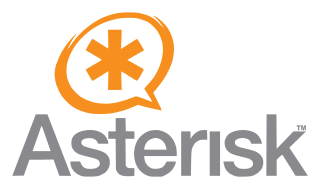Related Research Articles
Multiprotocol Label Switching (MPLS) is a routing technique in telecommunications networks that directs data from one node to the next based on labels rather than network addresses. Whereas network addresses identify endpoints, the labels identify established paths between endpoints. MPLS can encapsulate packets of various network protocols, hence the multiprotocol component of the name. MPLS supports a range of access technologies, including T1/E1, ATM, Frame Relay, and DSL.
Quality of service (QoS) is the description or measurement of the overall performance of a service, such as a telephony or computer network, or a cloud computing service, particularly the performance seen by the users of the network. To quantitatively measure quality of service, several related aspects of the network service are often considered, such as packet loss, bit rate, throughput, transmission delay, availability, jitter, etc.
The Session Initiation Protocol (SIP) is a signaling protocol used for initiating, maintaining, and terminating communication sessions that include voice, video and messaging applications. SIP is used in Internet telephony, in private IP telephone systems, as well as mobile phone calling over LTE (VoLTE).

Frame Relay is a standardized wide area network (WAN) technology that specifies the physical and data link layers of digital telecommunications channels using a packet switching methodology. Originally designed for transport across Integrated Services Digital Network (ISDN) infrastructure, it may be used today in the context of many other network interfaces.
Telephony is the field of technology involving the development, application, and deployment of telecommunication services for the purpose of electronic transmission of voice, fax, or data, between distant parties. The history of telephony is intimately linked to the invention and development of the telephone.
Voice over Internet Protocol (VoIP), also called IP telephony, is a method and group of technologies for voice calls for the delivery of voice communication sessions over Internet Protocol (IP) networks, such as the Internet.
Enhanced 911 is a system used in North America to automatically provide the caller's location to 911 dispatchers. 911 is the universal emergency telephone number in the region. In the European Union, a similar system exists known as E112 and known as eCall when called by a vehicle.

Asterisk is a software implementation of a private branch exchange (PBX). In conjunction with suitable telephony hardware interfaces and network applications, Asterisk is used to establish and control telephone calls between telecommunication endpoints such as customary telephone sets, destinations on the public switched telephone network (PSTN) and devices or services on voice over Internet Protocol (VoIP) networks. Its name comes from the asterisk (*) symbol for a signal used in dual-tone multi-frequency (DTMF) dialing.
Cisco Discovery Protocol (CDP) is a proprietary data link layer protocol developed by Cisco Systems in 1994 by Keith McCloghrie and Dino Farinacci. It is used to share information about other directly connected Cisco equipment, such as the operating system version and IP address. CDP can also be used for On-Demand Routing, which is a method of including routing information in CDP announcements so that dynamic routing protocols do not need to be used in simple networks.
A public data network (PDN) is a network established and operated by a telecommunications administration, or a recognized private operating agency, for the specific purpose of providing data transmission services for the public.
The next-generation network (NGN) is a body of key architectural changes in telecommunication core and access networks. The general idea behind the NGN is that one network transports all information and services by encapsulating these into IP packets, similar to those used on the Internet. NGNs are commonly built around the Internet Protocol, and therefore the term all IP is also sometimes used to describe the transformation of formerly telephone-centric networks toward NGN.
An Integrated Access Device is a customer premises device that provides access to wide area networks and the Internet. Specifically, it aggregates multiple channels of information including voice and data across a single shared access link to a carrier or service provider PoP. The access link may be a T1 line, a DSL connection, a cable (CATV) network, a broadband wireless link, or a metro-Ethernet connection.
Gizmo5 was a voice over IP communications network and a proprietary freeware soft phone for that network. On November 12, 2009, Google announced that it had acquired Gizmo5. On March 4, 2011, Google announced that the service would be discontinued as of April 3, 2011.
This is a comparison of voice over IP (VoIP) software used to conduct telephone-like voice conversations across Internet Protocol (IP) based networks. For residential markets, voice over IP phone service is often cheaper than traditional public switched telephone network (PSTN) service and can remove geographic restrictions to telephone numbers, e.g., have a PSTN phone number in a New York area code ring in Tokyo.

Jingle is an extension to XMPP which adds peer-to-peer (P2P) session control (signaling) for multimedia interactions such as in Voice over IP (VoIP) or videoconferencing communications. It was designed by Google and the XMPP Standards Foundation. The multimedia streams are delivered using the Real-time Transport Protocol (RTP). If needed, NAT traversal is assisted using Interactive Connectivity Establishment (ICE).
A VoIP VPN combines voice over IP and virtual private network technologies to offer a method for delivering secure voice. Because VoIP transmits digitized voice as a stream of data, the VoIP VPN solution accomplishes voice encryption quite simply, applying standard data-encryption mechanisms inherently available in the collection of protocols used to implement a VPN.
Mobile VoIP or simply mVoIP is an extension of mobility to a voice over IP network. Two types of communication are generally supported: cordless telephones using DECT or PCS protocols for short range or campus communications where all base stations are linked into the same LAN, and wider area communications using 3G or 4G protocols.
T.38 is an ITU recommendation for allowing transmission of fax over IP networks (FoIP) in real time.

Empathy was an instant messaging (IM) and voice over IP (VoIP) client which supported text, voice, video, file transfers, and inter-application communication over various IM communication protocols.
A VoIP gateway is a gateway device that uses Internet Protocols to transmit and receive voice communications (VoIP).
References
- ↑ Voice over Frame Relay, Alliance Datacom. on line November 28, 2007.
- ↑ VoFR Definition, pcmag.com encyclopedia. Accessed on line November 28, 2007.